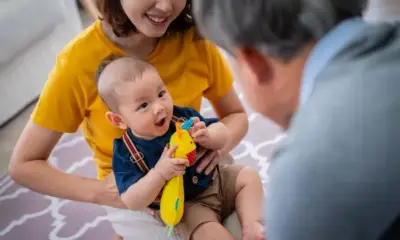Activities & Play
12 Best Gross Motor Activities to Support Infant Development

Gross motor activities for infants involve engaging their largest muscles, such as the torso, legs, and arms. These activities are crucial for developing motor skills, improving physical activity levels, and supporting cognitive growth. Research suggests that they contribute to better cardiorespiratory fitness and help maintain a healthy body mass index (BMI).
Importance of Gross Motor Skills in Infants
According to the World Health Organization (WHO), infants should participate in gross motor activities for a few hours daily to enhance their motor skills. These activities include standing, walking, crawling, and kicking. While young infants have a limited range of physical activities, their gross motor skills develop rapidly. Key developmental milestones include:
- Standing briefly without support
- Pulling up using objects for support
- Sitting unassisted
- Taking small steps
- Reaching for their toes
12 Best Gross Motor Activities for Infants
1. Tummy Time
Placing your baby on their tummy strengthens their shoulder and neck muscles, encourages movement, and prevents flat spots on their head.
2. Rolling a Ball
Sitting with support, your baby can engage in rolling a ball back and forth, which strengthens lower body muscles and improves balance and hand-eye coordination.
3. Playing with Blocks
Encouraging your baby to crawl towards a stack of blocks helps develop their movement and coordination.
4. Allowing Free Movement
Giving infants space to move freely supports their gross motor development by promoting body awareness and coordination.
5. Toy Bin Treasure Hunt
Letting babies explore a toy-filled basket stimulates sensory skills while strengthening their grasp and movement abilities.
6. Playing with Sensory Bags
DIY sensory bags filled with beads and water offer a tactile experience that supports hand-eye coordination.
7. Painting
Using safe, non-toxic paints helps infants develop their arm and hand muscles while engaging their senses.
8. Kicking a Balloon or Ball
Placing balloons or balls around a play mat encourages babies to kick, strengthening their leg muscles and promoting movement.
9. Pulling a Stuffed Toy
Attaching a ribbon to a stuffed toy allows babies who are beginning to walk to engage their motor skills by pulling it along.
10. Climbing a Box
Providing a sturdy, decorated box for infants to push or climb helps develop arm and leg strength.
11. Crossing Tunnels
Creating a tunnel with blankets encourages crawling and exploration, enhancing coordination and mobility.
12. Playing on a Texture Mat
Using a mat with various textures allows babies to explore different surfaces, promoting sensory and motor skill development.
Tips for Encouraging Gross Motor Skills
- Provide a safe, open space for movement
- Engage in activities that enhance core strength
- Use obstacle courses to encourage problem-solving
- Incorporate supervised swimming or water play
- Limit screen time to promote physical activity
- Encourage observation of other children’s movements
- Offer positive reinforcement to build confidence
Frequently Asked Questions
What motor skills do infants develop first?
By two months, babies begin moving their arms and legs. Rolling over, head control, and sitting follow as they grow.
Is clapping a gross motor skill?
No, clapping is a fine motor skill that typically develops around nine months.
Is waving a gross or fine motor skill?
Waving is a gross motor skill requiring coordination and muscle control.
Final Thoughts
Engaging infants in appropriate gross motor activities is essential for their physical and cognitive development. While each child grows at their own pace, significant delays in motor skill development should be discussed with a pediatrician.












